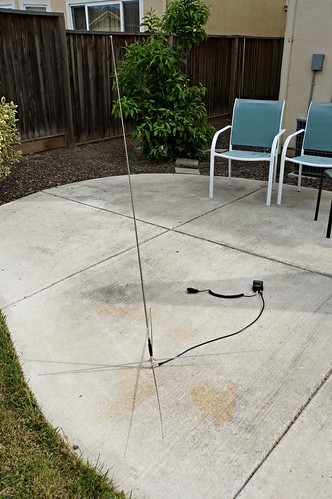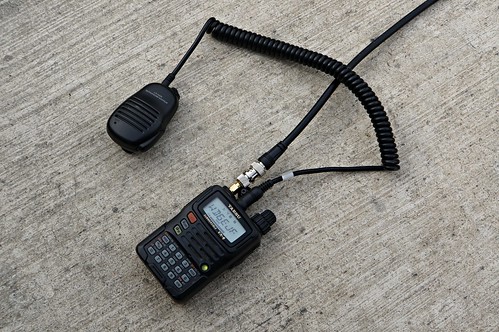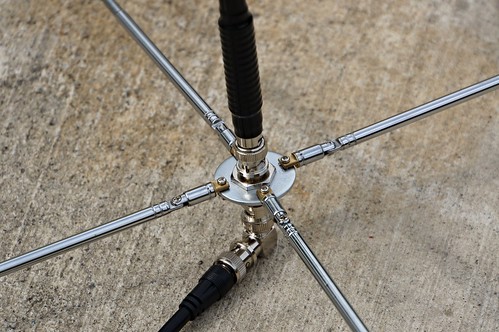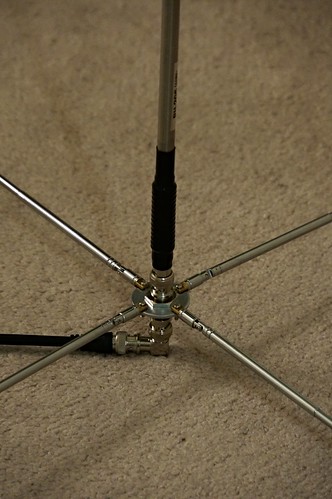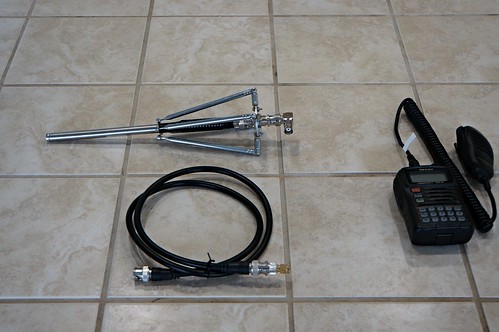Things just didn't go my way today.
When I got to the entrance of Lynch Canyon Open Space (where the trailhead is located), the gate was locked; it seems that the park is only open Friday through Monday.
Using the "Nearby" function in the handy SOTA Goat app, I discovered another SOTA summit approximately two miles south of my location: W6/NC-406, Sulphur Springs Mtn., located on public parkland in Vallejo. I did some quick research to try and determine the best way to access it. It appears that a trail from the west, originating in Blue Rock Springs Park in the city of Vallejo proper, leads to it, although I was unsuccessful in getting there. Either the trail I was on continued far to the north of Sulphur Springs Mtn. before rounding a hill and heading back southeast to it, or I was on the wrong trail. Either way, by 3 p.m. I was running out of time and gave up for the day. Upon further research (reading a blog post by a previous SOTA activator--which I should have done at the beginning), I learned of another (apparently much shorter) trail that approaches from the east side in the Hiddenbrooke subdivision.
Although I am disappointed that I was unable to activate today, I now have two nearby summits on my wishlist for the near future: Pt. 970 (still) and Sulphur Springs Mtn.
Thursday, April 28, 2016
Monday, April 25, 2016
SOTA Alert: Pt. 970, W6/NC-422
Thursday 28 April 2016, 20:00 UTC (1:00 p.m. local time)
52.525 MHz-FM, 146.520 MHz-FM, 446.000 MHz-FM
This will be my second Summits-on-the-Air activation. This time, I'm planning to attempt contacts on 6 meters, 70 cm, and 2 meters, in that order. This will be an opportunity for the first real field test of my new homebrew portable 2-meter antenna.
52.525 MHz-FM, 146.520 MHz-FM, 446.000 MHz-FM
This will be my second Summits-on-the-Air activation. This time, I'm planning to attempt contacts on 6 meters, 70 cm, and 2 meters, in that order. This will be an opportunity for the first real field test of my new homebrew portable 2-meter antenna.
Labels:
2 meter,
6 meter,
70 cm,
activation,
fm,
pt. 970,
sota,
summits on the air
Saturday, April 23, 2016
LoTW-enabled
I'm finally in Logbook of The World. There was quite a learning curve for me to figure out how to get started, but I finally got it. So far, I have seven QSOs:
...and I already have one QSL!
Thursday, April 21, 2016
My First Homebrew: In Action
On Tuesday, April 19, I conducted the first "field test" of my new portable 2-meter antenna. The test location was the backyard of my house.
First, I tried two repeaters on nearby Mt. Vaca; I got very good signal reports on both, which was to be expected. Next I tried the WD6EJF repeater, located 68.78 miles away to the south-southeast on Mt. Oso, and got a favorable report. I also logged one simplex contact with Jim, KI6AZH, in Auburn--almost 56 miles (90 km) away to the northeast. Considering the fact that the antenna was sitting on the ground, and there are several two-story structures close by to the north and south, I think the initial results were pretty good. With higher elevation--and fewer vertical obstructions--I feel confident that I will log contacts at some impressive distances.
The author of the article from which I built this antenna states that best results are achieved by fully extending all whips and tilting the vertical whip slightly away from the desired direction of transmission. As seen below, this is easily achieved.
First, I tried two repeaters on nearby Mt. Vaca; I got very good signal reports on both, which was to be expected. Next I tried the WD6EJF repeater, located 68.78 miles away to the south-southeast on Mt. Oso, and got a favorable report. I also logged one simplex contact with Jim, KI6AZH, in Auburn--almost 56 miles (90 km) away to the northeast. Considering the fact that the antenna was sitting on the ground, and there are several two-story structures close by to the north and south, I think the initial results were pretty good. With higher elevation--and fewer vertical obstructions--I feel confident that I will log contacts at some impressive distances.
The author of the article from which I built this antenna states that best results are achieved by fully extending all whips and tilting the vertical whip slightly away from the desired direction of transmission. As seen below, this is easily achieved.
My First Homebrew: Construction
I found the plans for this portable 2-meter antenna on page 32 of Portable Antenna Classics, published by the American Radio Relay League (ARRL). To quote from the article, "It is best described as a telescoping 5/8-wavelength vertical whip antenna above a ground plane of four folding telescoping quarter-wave radial whips." It makes a great first project for a new ham.
For the vertical antenna, I used a Diamond RH205 base-loaded telescoping 2-meter whip. For the ground plane, I used four 19.3-inch 6-section whips (hinged at the base, with a 2.5 mm hole at the mounting end).
Construction centers on a steel washer; I used one with a diameter of about 1-1/2 inches (4 cm). I drilled four equally-spaced 2.5-mm holes around its circumference. The washer was then mounted on an Amphenol BNC female-to-female connector with a threaded body for panel mounting. I tightened the washer in place with the lock washer and nut that came with the connector. I mounted one of the smaller whips to each of the 2.5-mm holes, using machine screws, lock washers and nuts.
A 3-foot length of coax cable with male BNC connectors at each end connects the bottom of the Amphenol connector to the radio (in my case, a female BNC to male SMA adapter is needed to connect to my Yaesu VX-6R).
The only liberty I took with the original plan was to add a 90-degree BNC female-to-male adapter to the bottom connector; the original plan has the coax plugging straight up into the bottom connector. I'm not yet sure if this change will affect the efficiency of the antenna. I hope to acquire an SWR meter soon.
As I said before, this is a great first project for a new ham. There is no soldering or welding involved; the most difficult part (and not too badly so) was drilling the four holes in the steel washer.
With all whips fully extended, the antenna stands 54 inches (137.16 cm) tall and 40 inches (101.6 cm) wide. It folds and telescopes down to a small package of 10 by 3 inches (25.4 x 7.6 cm).
With all whips fully extended, the antenna stands 54 inches (137.16 cm) tall and 40 inches (101.6 cm) wide. It folds and telescopes down to a small package of 10 by 3 inches (25.4 x 7.6 cm).
In my next post, I'll discuss my first test of the new antenna. Below are a few photos of the finished product.
Wednesday, April 13, 2016
Future SOTA Activations
I'm already considering my next activations. The most likely candidates at this point include, but are not limited to:
- W6/NS-357, Pine Hill -- hopefully, in the very near future.
- W6/NS-135, Maggies Peaks -- this will most likely happen in the second-to-last week of June, during a family vacation at South Lake Tahoe.
SOTA W6/CV-017, 12 April 2016: More Details
My Rig
For this first activation, I used a dual-band Wouxun KG-UV5D handheld (6 meters and 2 meters [4 watts and 5 watts, respectively]) with a Maldol MH-510 20.5-inch whip antenna. The MH-510 is 1/4-wave for both bands (5/8-wave for 70 cm, as well). I received good signal reports for most of my contacts, all of which were on 2 meters this time.
Contacts Logged (call, name, location, distance), all on 2m FM at 5 watts
WB6DTB -- Dave, Oakley, CA -- 26.71 miles (42.98 km)
AG6EL -- Craig, Volcano, CA -- 75.54 miles (121.57 km)
KM6AAI -- Al, Fair Oaks, CA -- 46.27 miles (74.47 km)
K5JCH -- John, Placerville, CA -- 76.37 miles (122.91 km)
W6DWO -- Dave, Grass Valley, CA -- 76.02 miles (122.34 km)
Labels:
2 meter,
activation,
antenna,
contacts,
fm,
handheld,
kg-uv5d,
maldol,
mh-510,
pt. 968,
sota,
summits on the air,
transceiver,
vhf,
wouxun
Tuesday, April 12, 2016
Activation Report: SOTA W6/CV-017
My first SOTA activation was a success, although I can't say it went off without a hitch.
Pt. 968 is located in Lagoon Valley Regional Park in Vacaville, California. It gets its name from its elevation, 968 feet above sea level. The hike from the trailhead to the summit is approximately 1.6 miles (2.55 km). I found the grade pretty grueling at places, especially during my first trip up (more on that later). There was lots of wildlife along the way, including a close encounter with a turkey; that helped make the hike a little more pleasurable.
I reached the summit at approximately the scheduled time (11:00 a.m.). I shot a few photos while I caught my breath and mentally prepared myself for my first CQs. When I opened my pack to assemble my radio (a Wouxun KG-UV5D handheld), I discovered a problem that would prevent me from being able to make any contacts.
I headed back down the hill, determined that my first activation would happen today. When I got back to my car, I posted a new alert with a scheduled time of 1:00 p.m. I then started back up the hill, this time with the antenna that I had left on the car seat. Fortunately for me, the hike up the hill was easier the second time around. Upon my return to the summit I rested for a little while and had a long drink of water.
At approximately 12:35, I spotted myself on SOTAwatch to announce that I was ready. My plan was to work 2 meters (146.520 MHz) for a while, then switch over 6 meters (52.525 MHz) on the slim chance that I might find someone monitoring that band. I put out my first CQ at 12:40; almost immediately, Dave, WB6DTB responded--he was in Oakley, to the southeast.
It was over an hour before I made my next successful simplex contact. In retrospect, Tuesday in the early afternoon is not an ideal time for contacts because many people tend to be at work (it happens to be one of my days off). After many unsuccessful calls, I decided to switch to 146.550 and try my luck there--I've occasionally seen it listed on SOTA alerts for US activators. I eventually connected with Craig, AG6EL, in Pine Grove. This fairly long-distance contact worked because it was line-of-sight across the Sacramento Valley to the Sierra Nevada mountains on the other side; Pine Grove is at approximately 2500 feet elevation.
The actual distances involved are included in the next post.
After another half an hour of fruitless calling, I decided to try of the local repeaters and see if I could drum up a few people willing to switch over for simplex contacts. I came upon an acquaintance, Al, KM6AAI, who was willing to go over to 146.55. When I got there, there was a mini pileup of Al and two other operators waiting for me. After KM6AAI, I worked John, K5JCH in Placerville and Dave, W6DWO (Grass Valley) in quick succession. Placerville and Grass Valley are also at fairly high elevations in the Sierra Nevada.
Having spent almost two hours on (and made two trip up to) the summit, and with five contacts logged, I called it a day and headed home. I had no luck on 6 meters, which was not a surprise. I wish it was more active around here.
Below are some photos that I shot during my first trek up in the morning.
Pt. 968 is located in Lagoon Valley Regional Park in Vacaville, California. It gets its name from its elevation, 968 feet above sea level. The hike from the trailhead to the summit is approximately 1.6 miles (2.55 km). I found the grade pretty grueling at places, especially during my first trip up (more on that later). There was lots of wildlife along the way, including a close encounter with a turkey; that helped make the hike a little more pleasurable.
I reached the summit at approximately the scheduled time (11:00 a.m.). I shot a few photos while I caught my breath and mentally prepared myself for my first CQs. When I opened my pack to assemble my radio (a Wouxun KG-UV5D handheld), I discovered a problem that would prevent me from being able to make any contacts.
I headed back down the hill, determined that my first activation would happen today. When I got back to my car, I posted a new alert with a scheduled time of 1:00 p.m. I then started back up the hill, this time with the antenna that I had left on the car seat. Fortunately for me, the hike up the hill was easier the second time around. Upon my return to the summit I rested for a little while and had a long drink of water.
At approximately 12:35, I spotted myself on SOTAwatch to announce that I was ready. My plan was to work 2 meters (146.520 MHz) for a while, then switch over 6 meters (52.525 MHz) on the slim chance that I might find someone monitoring that band. I put out my first CQ at 12:40; almost immediately, Dave, WB6DTB responded--he was in Oakley, to the southeast.
It was over an hour before I made my next successful simplex contact. In retrospect, Tuesday in the early afternoon is not an ideal time for contacts because many people tend to be at work (it happens to be one of my days off). After many unsuccessful calls, I decided to switch to 146.550 and try my luck there--I've occasionally seen it listed on SOTA alerts for US activators. I eventually connected with Craig, AG6EL, in Pine Grove. This fairly long-distance contact worked because it was line-of-sight across the Sacramento Valley to the Sierra Nevada mountains on the other side; Pine Grove is at approximately 2500 feet elevation.
The actual distances involved are included in the next post.
After another half an hour of fruitless calling, I decided to try of the local repeaters and see if I could drum up a few people willing to switch over for simplex contacts. I came upon an acquaintance, Al, KM6AAI, who was willing to go over to 146.55. When I got there, there was a mini pileup of Al and two other operators waiting for me. After KM6AAI, I worked John, K5JCH in Placerville and Dave, W6DWO (Grass Valley) in quick succession. Placerville and Grass Valley are also at fairly high elevations in the Sierra Nevada.
Having spent almost two hours on (and made two trip up to) the summit, and with five contacts logged, I called it a day and headed home. I had no luck on 6 meters, which was not a surprise. I wish it was more active around here.
Below are some photos that I shot during my first trek up in the morning.
A view of the summit from below while hiking up.
A look back at Lagoon Valley while hiking up.
Looking easterly toward Vacaville while hiking up.
One the many butterflies on the summit.
Looking east, with the state prison and part of Vacaville below.
Looking south. In the distance, beyond the dip in the hill at the center,US Air Force C-5 Galaxies and C-17 Globemaster IIs are visible on the tarmac at Travis AFB.
Looking southwest toward the city of Fairfield.
Looking west, with Lagoon Valley at the center. The starting point for the hike was near the trees at the bottom right corner of the lake.
A view of Vacaville, looking north.
Saturday, April 9, 2016
SOTA Alert: Pt. 968, W6/CV-017
Tuesday 12 May 2016, 18:00 UTC (11:00 a.m. local time)
52.525 MHz-FM, 146.520 MHz-FM
This will be my first Summits-on-the-Air (SOTA) activation. It's only worth one point, but it's only 12 miles from my house and fairly easily accessible. I will be working the the 6-meter band with a Wouxun KG-UV5D and the 2-meter band with a Yaesu VX-6R. The location is near the southern edge of the city of Vacaville and the western edge of the Sacramento Valley (California), with line of sight to a number of cities, including Vacaville, Fairfield, Dixon, and a large swath of the Valley.
The scheduled time is tentative, depending upon how the morning goes. My only request to anyone who tries to work me is to have patience with me on my first activation!
52.525 MHz-FM, 146.520 MHz-FM
This will be my first Summits-on-the-Air (SOTA) activation. It's only worth one point, but it's only 12 miles from my house and fairly easily accessible. I will be working the the 6-meter band with a Wouxun KG-UV5D and the 2-meter band with a Yaesu VX-6R. The location is near the southern edge of the city of Vacaville and the western edge of the Sacramento Valley (California), with line of sight to a number of cities, including Vacaville, Fairfield, Dixon, and a large swath of the Valley.
The scheduled time is tentative, depending upon how the morning goes. My only request to anyone who tries to work me is to have patience with me on my first activation!
Labels:
2 meter,
6 meter,
activation,
fm,
kg-uv5d,
sota,
summits on the air,
vx-6r,
wouxun,
yaesu
Tuesday, April 5, 2016
Plans for the Near Future
I have several projects in the pipeline; I'll be sure to post progress reports on them as warranted. They are listed below in the order in which they are most likely to happen.
1. My First "Summits-on-the-Air" (SOTA) Activation -- Pt. 968, W6/CV-017 (above Vacaville, California): this is very likely to occur within the next week.
2. My First "Homebrew" Antenna -- I've decided to build a portable 2-meter vertical antenna that I found on page 32 of Vertical Antenna Classics (ARRL, 1995). It is lightweight and of simple construction--perfect for a newbie like me. My goal is to extend the range of my handheld radio during SOTA activations. I've ordered most of the parts I need and hope to start construction soon.
3. General Class License -- I have been studying, slowly making my way through the license manual. I suspect it will be at least another month before I'm ready to take the test.
1. My First "Summits-on-the-Air" (SOTA) Activation -- Pt. 968, W6/CV-017 (above Vacaville, California): this is very likely to occur within the next week.
2. My First "Homebrew" Antenna -- I've decided to build a portable 2-meter vertical antenna that I found on page 32 of Vertical Antenna Classics (ARRL, 1995). It is lightweight and of simple construction--perfect for a newbie like me. My goal is to extend the range of my handheld radio during SOTA activations. I've ordered most of the parts I need and hope to start construction soon.
3. General Class License -- I have been studying, slowly making my way through the license manual. I suspect it will be at least another month before I'm ready to take the test.
Phonetic Alphabet
Because many letters of the English language sound similar, phonetic alphabets have been developed to avoid confusion when transmitting them by voice over the radio. Below is the phonetic alphabet most commonly used by amateur radio operators.
Alpha
Bravo
Charlie
Delta
Echo
Foxtrot
Golf
Hotel
India
Juliet
Kilo
Lima
Mike
November
Oscar
Papa
Quebec
Romeo
Sierra
Tango
Uniform
Victor
Whiskey
X-ray
Yankee
Zulu
Phonetically, my call sign is "Kilo Kilo Six Zulu Lima X-ray"--say that three times fast...quite a mouthful, isn't it?
(This post is as much a practice exercise for me as it is meant to be information for my readers.)
Alpha
Bravo
Charlie
Delta
Echo
Foxtrot
Golf
Hotel
India
Juliet
Kilo
Lima
Mike
November
Oscar
Papa
Quebec
Romeo
Sierra
Tango
Uniform
Victor
Whiskey
X-ray
Yankee
Zulu
Phonetically, my call sign is "Kilo Kilo Six Zulu Lima X-ray"--say that three times fast...quite a mouthful, isn't it?
(This post is as much a practice exercise for me as it is meant to be information for my readers.)
Subscribe to:
Posts (Atom)

